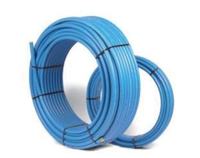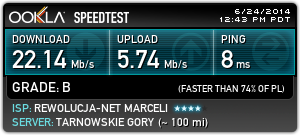FAQ
TL;DR: 72 % of European FTTH installs terminate the fibre at an indoor ONT and switch to Ethernet/Wi-Fi [FTTH Council, 2022]. “Bend it too much and it will stop working” [Elektroda, Heinzek, post #13738485] Keep ≥20 mm bend radius, use 40 mm HDPE conduit, and test speed after install.
Why it matters: Planning the drop, conduit and devices avoids speed loss, outages and extra call-outs.
Quick Facts
• GPON optical power budget: 28 dB (Class B+) [ITU-T G.984.2].
• Minimum bend radius, indoor FTTH drop: 20–30 mm [Corning, 2021].
• Underground conduit: 40 mm HDPE, burial depth ≈60 cm [Telekom Guide, 2020].
• ONT (Dasan H640GV) power draw: 6–12 W [Dasan Spec, 2021].
• Installer patch-cord stock lengths: 2-25 m [Elektroda, Heinzek, post #13738552]
How will the fibre be routed from the pole to my house?
The installer fastens an aerial drop to the pole, then feeds it down your wall or through your pre-laid conduit. In single-family homes the provider must deliver service to one agreed entry point; you supply any conduit or trenching [Elektroda, voitek1, post #12267754]
May the fibre ride 2 m below existing power lines on the mast?
Yes. The cable carries no voltage or electromagnetic field, so clearance rules for power conductors do not apply; ensure only that the fibre remains uncrushed and respects its bend radius [Elektroda, voitek1, post #12267602]
What conduit and depth should I use if I bury the drop?
Use a smooth-wall or corrugated 40 mm HDPE pipe, laid about 60 cm deep to avoid garden tools. Pull a draw-string first for easy cable insertion [Telekom Guide, 2020; Elektroda, voitek1, #12267717].
Do I need permits to run the cable underground from a power pole?
Usually not, because the easement already covers telecommunications. Still, your provider must approve any alteration to their outside plant; contact them before digging [Elektroda, jimasek, post #12277720]
Which devices appear inside the house?
- Optical socket (splice box).
- ONT/ONU such as Dasan H640GV with 1-4 Ethernet ports [Elektroda, LONGER1991, post #12286738]
- Your own router or switch. The ONT needs a 230 V outlet and supplies standard Gigabit Ethernet.
How far can I run a fibre patch-cord indoors?
Installers carry cords up to 25 m; GPON budgets allow 20 km, so 5–25 m inside adds negligible loss [Elektroda, Heinzek, post #13738512]
What bend radius should I keep?
Stay above 20–30 mm for standard bend-insensitive drop cables. A 10 mm loop can add 30 dB loss—enough to break the link [Corning, 2021].
I ordered 10 Mb/s but see 4.5 Mb/s and dropouts—why?
Low-end routers or duplex mismatches can halve throughput and cause packet loss [Elektroda, voitek1, post #12287718] Check that LAN cards use auto-negotiation and test directly from ONT before the router.
How do I test packet loss correctly?
Use WinMTR or similar continuous traceroute. Four ICMP pings can miss transient issues [Elektroda, Anonymous, post #12287951]
What happens if the fibre gets sharply bent or crushed?
Edge-case: Micro-bending can cause intermittent sync; macro-bending below 10 mm may break the glass, requiring a splice truck visit (≈€150 call-out) [Corning, 2021]. “Straighten it and it works again” confirms bend loss rather than fracture [Elektroda, Heinzek, post #13738485]
Can I relocate the ONT later?
Yes. Replace the patch-cord with a longer one or use an adapter coupler. Keep total indoor length under 30 m for easier handling [Elektroda, Heinzek, post #13738552]
How do I prepare the conduit before installers arrive?
How-To: 1. Lay 40 mm HDPE pipe from pole root to entry point, slope away from house. 2. Feed a nylon draw-rope and cap both ends. 3. Leave at least 1 m spare at each end for weather loops. The crew will pull, splice and seal the fibre the same day [Elektroda, voitek1, post #12267717]
 I want to order fiber optic internet, but I'm not sure how exactly it is assembled. The optical fiber is connected to the house with a plug> plug to the converter> twisted pair from the converter to the router> from the router with twisted pair to computers or via wifi, maybe they will install it for me otherwise? With this, it will not be a big problem, the more I wonder if there can be an optical fiber pulled from the power pole to the mast from the electrical wires that I have on the wall. On the pole, the optical fiber is about 2m under the power cables, for me on the mast there would also be 2m under the cables, but I do not know if they can mount it this way or are it not precluded by any regulations or some other contraindications? Alternatively, what hooks to the wall should be used to attach the optical fiber from the pole, there is 14cm polystyrene on the wall.
I want to order fiber optic internet, but I'm not sure how exactly it is assembled. The optical fiber is connected to the house with a plug> plug to the converter> twisted pair from the converter to the router> from the router with twisted pair to computers or via wifi, maybe they will install it for me otherwise? With this, it will not be a big problem, the more I wonder if there can be an optical fiber pulled from the power pole to the mast from the electrical wires that I have on the wall. On the pole, the optical fiber is about 2m under the power cables, for me on the mast there would also be 2m under the cables, but I do not know if they can mount it this way or are it not precluded by any regulations or some other contraindications? Alternatively, what hooks to the wall should be used to attach the optical fiber from the pole, there is 14cm polystyrene on the wall.




